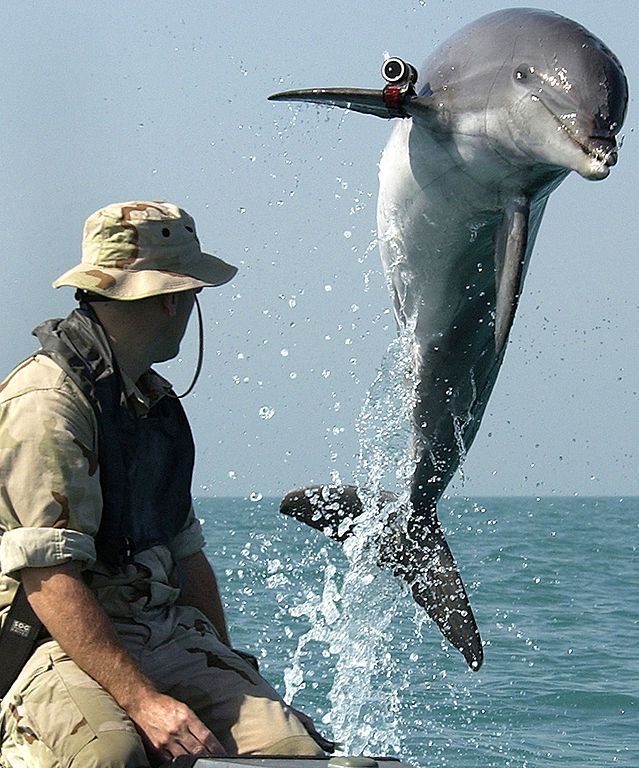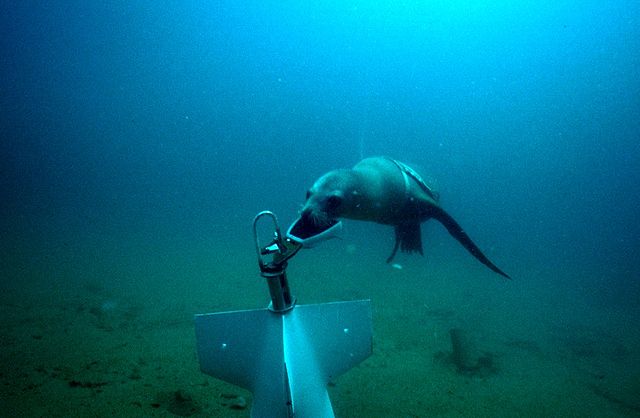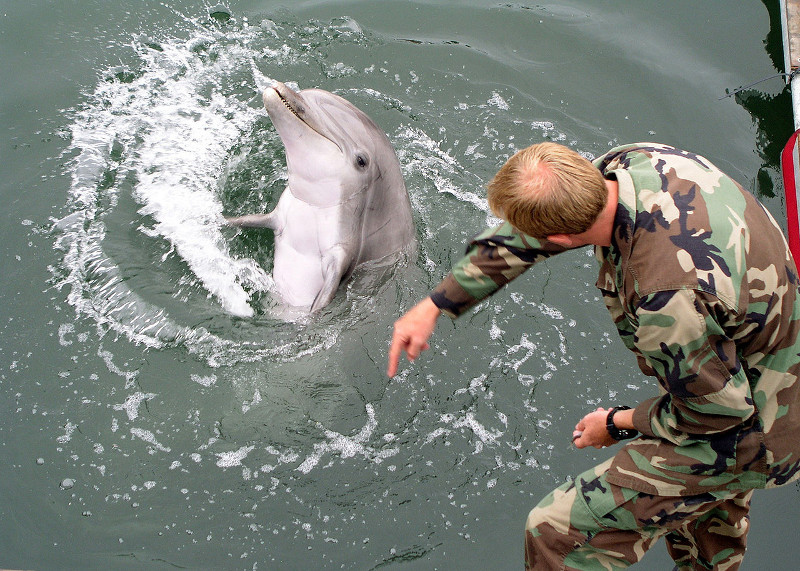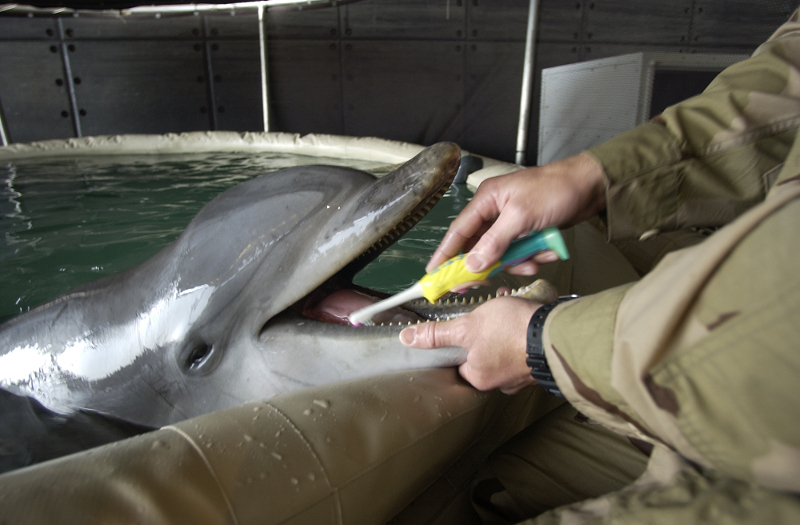Those who followed the news of Russian annexation of Crimea earlier this year may remember that one of the stranger stories to come out of the controversy involved the Russian take-over of a certain unit of the Ukrainian military. This was no ordinary military unit, however, but rather one that included bottlenose dolphins and California sea lions. The Crimean city of Sevastopol is one of only two places in the world where these two species are trained for military use; the other is San Diego, home of the U.S. Navy Marine Mammal Program. Dolphins and sea lions have been used for military purposes for over 50 years, since competition between the U.S. and the USSR during the Cold War led both sides to develop their own marine-mammal programs. Since the 1960s, marine mammals have been used in a number of conflict locations, including Vietnam, the Persian Gulf and Bahrain. Using marine mammals in the military is not without controversy, however.
The idea of harnessing these creatures’ unique abilities for military use began in 1960 in the U.S., when the Navy acquired a Pacific white-sided dolphin in order to gain inspiration for better torpedo designs from the dolphin’s hydrodynamic form. Further studies of different dolphin species led to the realization that there was much more to learn from the animals’ exceptional abilities, including their natural sonar and their tolerance for diving to impressive depths. This led to the birth of the Navy Marine Mammal Program, designed not only to research the dolphins’ talents, but also to determine whether they and other marine creatures could be used to carry out certain tasks for the Navy. One of the first cases of a dolphin successfully completing a military task occurred in 1965, when a member of the program named Tuffy delivered tools and messages to the SEALAB II project 200 feet (60m) below the surface. In the same year, the USSR’s launched a marine mammal program in Sevastopol’s Cossack Bay.
Although the Navy Marine Mammal Program has experimented with using several different species including orcas, belugas, elephant seals and even sharks, both the U.S. and the USSR decided that for their trainability, their intelligence and their unique skill sets, bottlenose dolphins and California sea lions were the most useful species to their programs. The dolphins’ biggest asset is their powerful sonar, which far outstrips any human sonar technology, especially in shallow water where ship traffic and breaking surf often interfere with synthetic sonar devices. Both the San Diego and the Sevastopol dolphins are trained to detect underwater mines, which they mark for human mine-disposal teams by placing a weighted buoy line close by. Other tasks carried out by dolphins for these nations include retrieving lost items and defending warships against enemy swimmers, whereby the dolphins patrol moored vessels and alert trainers to the presence of any divers in the area.
Although rumors abound about specially trained “killer dolphins” on both sides, there is no evidence to suggest that the cetaceans have ever been used aggressively against humans. In 2013, media reports that dolphins equipped with knives strapped to their heads had escaped into the Black Sea from the Ukrainian Navy predictably turned out to be false. Similarly, the U.S. Navy adamantly denies that dolphins have ever been trained to attack enemy swimmers, and that they are rather used solely for defense. Sea lions also perform a defensive role in the San Diego and Sevastopol programs. Although sea lions don’t use sonar, they have exceptional underwater vision, particularly in low light; additionally, they possess excellent directional hearing underwater and have the advantage of being amphibious. Typically, they are used to retrieve objects including lost weaponry, which they do by attaching a device to the lost item, which allows human retrieval teams on the surface to reel it in. The U.S. Navy uses sea lions extensively in training exercises for explosives-disposal personnel, using the sea lions to retrieve practice mines unrecovered by their human counterparts.
Both the U.S. and the USSR marine mammal programs reached a peak during the 1980s, and both began to decline during the 1990s after the end of the Cold War. The Soviet Union dolphins became the property of the Ukraine, where many were given civilian roles including helping with the therapy for disabled children, while others were sold to Iran in 2000. The U.S. Navy Marine Mammal Program, which was top secret in its heyday, became declassified in 1993 and many of its animals were retired to research programs in Hawaii and a rehabilitation sanctuary in Florida. However, in recent years interest in the military value of marine mammals seems to have rekindled, first with the Ukraine’s decision in 2011 to relaunch their dolphin and sea-lion training program, and second with Russia’s keenness to redirect the Sevastopol facility towards their own requirements after annexing Crimea. The U.S. also seems to have refocused on its Marine Mammal Program. In April 2014, the spokesperson for the San Diego facility confirmed that 20 trained dolphins and 10 sea lions would be sent to the Black Sea to take part in a NATO drill that would test a new anti-radar system.
The use of marine mammals in the military predictably causes considerable controversy. Animal rights and some conservation groups maintain that it is morally unacceptable to involve animals in human conflict, expressing concerns about the welfare of military dolphins and sea lions including their living conditions when they’re not training, whether the animals are wild-caught or captive-bred, and the level of stress caused to them by an unnatural lifestyle. Many arguments against using marine mammals in the military also apply to captive dolphins in aquariums. These include reduced freedom of movement as a result of living in a pen rather than in the ocean and the separation of family members, something that is particularly stressful for species like dolphins and sea lions that have advanced social structures and familial bonds in the wild.
Other issues are specific to the animals’ role in the military, for example, the stress induced by transporting dolphins and sea lions from one combat zone to another (both in terms of the travel itself and in terms of exposing the animals to unfamiliar environmental conditions). Those who oppose the use of dolphins and sea lions for military purposes also cite the risk of physical harm to the animals as a result of the tasks they are given, ranging from accidental mine detonation while dolphins are in nearby to the targeting of both species by enemy forces. Finally, questions are often raised about how the animals are trained and what happens to them when they are retired from service.
Little is known about the way in which the Ukrainian (or rather, the Russian) dolphins and sea lions are trained and deployed, however, the U.S. Navy Marine Mammal Program maintains that it only uses positive reinforcement to train its animals, and that they are kept in conditions that adhere to the requirements of the Marine Mammal Protection Act and the Animal Welfare Act. It is also worth noting that the likelihood of a dolphin being harmed by an exploding mine is small, not only because they are trained not to touch the devices, but also because most mines are designed not to detonate upon accidental contact with a marine animal. Perhaps one of the best arguments in favor of military marine-mammal programs is that they contribute to our scientific knowledge of the species involved. Research meant to understand these animals’ advanced abilities plays a significant role in such programs, and research is often the key to environmental protection on a larger scale.
The future of these programs is uncertain. On one hand, Russian media has reported that the nation will be pumping funds into improving and advancing their newly acquired marine mammal unit. On the other, the BBC reported in 2012 that the U.S. Navy hopes to start phasing out the use of dolphins and sea lions in the military by 2017, replacing them instead with high-tech unmanned vehicles. Whether the two nations will continue to mirror each other’s marine-mammal programs or whether they will focus on drone technology instead is unclear. In either case, and regardless of which side of the ethical debate you fall on, it is certain that the marine-mammal programs in San Diego and Sevastopol highlight just how remarkable these animals really are.





